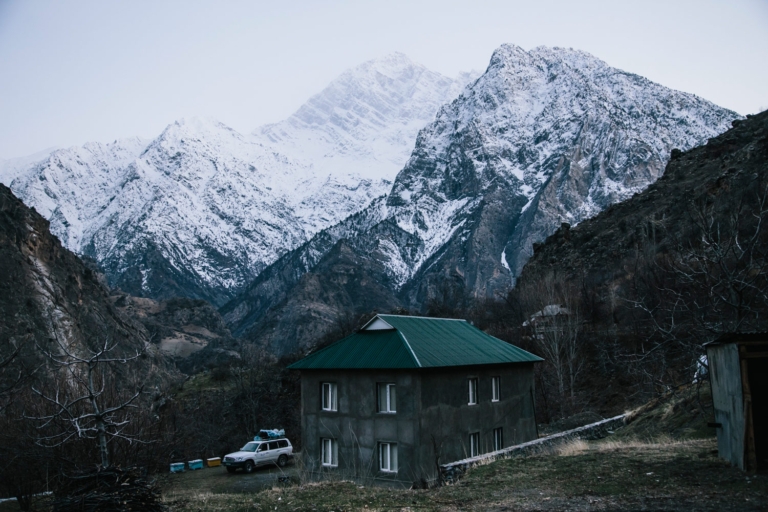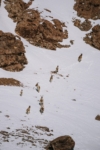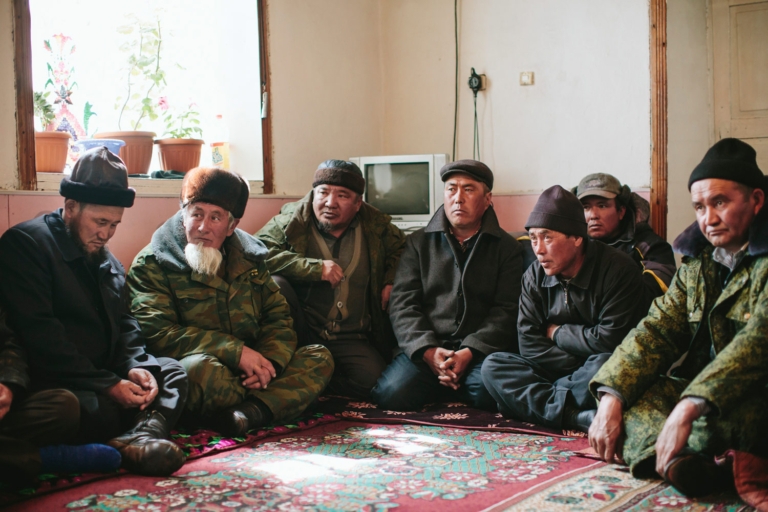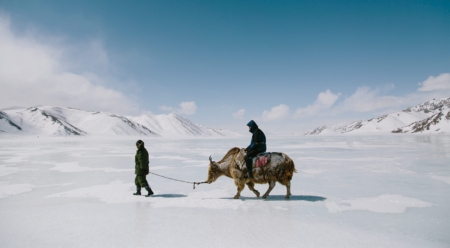Searching for the Snow Leopard in Tajikistan
March 11, Saidi Tagnob Conservancy, Zighar, Tajikistan
Odina, a Tajik ranger from the Saidi Tagnob Conservancy, squats alongside the cliff edge. With large field glasses pressed to his face, he scans the opposite mountainside for familiar movement. He motions excitedly for the spotting scope. I squint hopelessly across the ravine at I-know-not-what. And then I see them—three mature markhor! The females trail a larger, more impressive male, resplendent with enormous corkscrew horns and a wizened grey beard. The giant goat appears more like a creature from Star Wars and is a powerful reminder of how far I’ve traveled from home.
It’s day two on the Pamir Highway in a stuffed Land Cruiser. Topping out at over 15,000 feet, the iconic highway is the second highest in the world. Record snowfall means that every avalanche path that could run, has, and the crumbling road is particularly treacherous. Today, we parallel the Pyanj, a river fed from melting glaciers high in the mountains. Across the deep turquoise stream is Afghanistan, a mere 200 yards away. Dubbed the “Heroin Highway,” it is thought that nearly ninety tons of heroin are smuggled across this stretch of river every year.
I am traveling with National Geographic Explorer Tanya Rosen. Rosen is the regional director of Panthera’s snow leopard program in Central Asia. Our crew is small: Tanya’s husband Kyran, journalist Jason Goldman and two Tajiks, Munavvar and Jura. Over the course of the next ten days we will visit several community-based conservancies along Central Asia’s ancient Silk Road to cover the controversial use of trophy hunting in snow leopard conservation for bioGraphic Magazine. The survival of the snow leopard depends entirely on the tolerance and restraint of the people living within their habitat. These visits serve as an opportunity to reinforce trust, support ongoing projects, and prevent defection.
Rosen has spent years in the Pamir and Tian Shan Mountains and built an impressive network of Tajik and Kyrgyz rangers. These local rangers patrol vast territories, preventing the poaching and smuggling of leopards and their prey. As ungulates rebound, so do leopards—more prey, more predators. Once populations stabilize, the communities are permitted to host a small number of trophy hunts. Proceeds from these hunts benefit the community in the form of access to clean water, better schools and improved health care. This decentralized, bottom-up approach to wildlife management provides continued incentive for local people.

The first night we slept a few hundred yards from Afghanistan, along the Pyianj River. Photo: Joel Caldwell
March 12, Burgut Conservancy, Northern Alichur Range, GBAO, Tajikistan
Today marks our fourth day in Tajikistan. After a night in Khorog, we’ve left the Afghan border and climbed into the heart of the Pamir Mountains to the remote village of Alichur. We are staying with Mahan, head of the Burgut Marco Polo sheep and ibex conservancy.
Outside the village, Jura rallies the Land Cruiser through deep snow, roughly following a two-track off the main highway. When we can drive no further, out come the spotting scopes. A small herd of Marco Polo sheep—a subspecies of argali endemic to Tajikistan, southern Kyrgyzstan and northern China—are spotted along a ridge to the north. Leaving the group behind, I ski through a breakable crust two miles to the base of the ridge. At 13,000 feet my heart is beating out of my chest. I’m loaded down with camera equipment and at one particularly exhausting moment, while skinning up the steep ridge, it occurs to me that I’m a solitary animal, detached from the herd, in wolf country.
I can now easily make out the argali above. Seeing movement, I stop and quickly pull the big lens from my backpack. My breath catches as I watch the muscular sheep in full flight along the ridgeline. Just as I expect them to disappear from view, they abruptly stop and form a semicircle facing towards me. Click! The shutter releases. I pull skins and make a few crusty turns back down to the valley floor.
Back in Alichur, the small room is wreathed in the sweet smoke of burning dung and packed with people. I sit on the floor feeling suddenly, terribly nauseous. After tracking the sheep earlier in the day, I had skied several miles and spent hours more in the slow journey back to the village. Belatedly, I am realizing how thoroughly dehydrated I’ve become. Fighting panic, I begin drinking water as fast as possible, each gulp increasing my nausea. After forty-five minutes of sitting mutely against the wall, the ibuprofen finally lands and I feel worlds better. Days from any larger town, Alichur is not the place to get sick.
Before bed I step outside to look at the stars. The rugged beauty of the eastern Pamirs is astounding—dramatic peaks rip from the earth to impossible heights. The wind has blown away the cloud cover and I am stunned by the immediacy of the night sky. The Milky Way stands out in the darkness, brighter with each passing moment, but the cold is biting and I make my way back inside. Bed—a pallet on the floor alongside Munavvar, Jura and Jason—is plenty comfortable, but good sleep is hard to come by at this altitude.
In the morning, Jason wakes up with an ice mustache.

Tajik and Kyrgyz poachers are incentivized to promote healthy populations of ungulates because of their value as trophies to wealthy foreign hunters (ibex $5,000, Marco Polo $40,000, markhor $120,000). Side effect: snow leopard populations increase alongside those of their prey. Added bonus: money from sustainable, permitted hunts flows through community-based conservancies benefiting entire communities (access to clean water, schools, health care). It’s working. Snow leopard density, as detected by Panthera’s camera traps, is up. You can argue with the method, but not the results. Photo: Joel Caldwell
March 16, Karakol Lake, GBAO, Tajikistan
After three days in Alichur we part ways with Jura and Munavvar and continue north with Mahan. Our hope is to make it to Sarytash, just across the Kyrgyz border, where Mahan will hand us off to his Kyrgyz Panthera counterpart, Zairbek, before returning home. Six hours in, we’re averaging about 40 kilometers an hour. But as we begin to climb the road worsens, weather threatens and Mahan shifts no higher than second gear.
Tajikistan has had the same president since the collapse of the Soviet Union in 1991. Social media, when we found internet, is blocked. There is something decidedly unsettling about traveling through a country with defunct power lines stretching across the vast snowy emptiness, the skeletal remains of a more prosperous time, while the country continues a slow, depressing slide backwards.
Nine hours in, we parallel the border of China. The wall, a razor wire Soviet relic, partitions a no man’s land between the two countries. In places it is dilapidated and full of holes which Tanya says is helpful to migrating wildlife. It is cold—really cold. As we pass through the Valley of Death (so named because of the many snowbound drivers who’ve frozen to death) our truck’s thermometer registers minus 20 Celsius.
It’s full dark before we make it through the first checkpoint of the Tajik-Kyrgyz border. Customs takes longer than expected and Mahan has left the lights on so now the battery’s dead, which, I admit, makes me a bit nervous. The Kalashnikov-wielding border guards are nice enough to give us a jump, so Mahan completely removes the battery from their rig, uses it to start our car, and then reinstalls it—all in the brutal cold. The twelve-hour mark of our drive slips by.
After a long descent from the border post it begins nuking snow. Mahan, now nearing his fourteenth hour behind the wheel, is contending with drifts so bad that at times it’s impossible to tell where the road leads. He guns the old Land Cruiser time and time again as snow billows over the hood. After an interminable period—punctuated only by the brief silences between Pamiri pop songs—we come across an old Lada completely missing its front wheel. We load the extra four men into the Land Cruiser—can’t let them freeze to death! Nine bodies packed inside a tin can.
Patience is running thin and our truck, crammed with people, is nearly out of gas. To our great relief, at two o’clock in the morning along this desolate stretch of ancient road, our feeble headlights reveal Zairbek Kubanychbekov, the head of Panthera Kyrgyzstan. Somehow, help has arrived. Working as a team, we caravan the remaining distance to the guesthouse in Sarytash.

Slow going on the Pamir Highway. In several places, where avy debris had completely obliterated the road, Tanya coaxed the Land Cruiser through a slot the width of a single bulldozer, towering walls of rock and ice on either side. We craned our necks in the hopes that nothing else was on its way down. Photo: Joel Caldwell
March 18, Mingteke Conservancy, Alai Valley, Kyrgyzstan
Today we’ll visit three conservancies in the Alai Valley of southern Kyrgyzstan.
Tanya and Zairbek meet with various local officials. I’m impressed by the obvious rapport these two have with conservancy members and the thoughtful way they’ve built this movement—empowering local people and placing responsibility in their hands. Tanya offers support and encouragement and facilitates progress, but the onus lies with each individual conservancy.
At each of the three stops, we sit for a traditional meal. The first two are fairly palatable but the third is a gastro-trial. A bright, multicolored blanket is laid on the floor and our host throws (literally) round loaves of bread down, followed by countless bowls of apricot jelly, butter, sweet cookies, sugar cubes, and cheap Chinese candy. The meal begins with a round of fermented horse milk, or kumis. It’s viscous and faintly sweet at first, but finishes with a sour confusing flavor that can only be described as wretched. I sample a little here and there to be a good sport. Next to arrive is a hard cheese inside of a sheep’s lung. This I nibble on, the taste not nearly as offensive as the presentation. And lastly—the coup de grâce—is an entire goat head, charred, ears still attached. When this comes around my way I become so furiously engaged with my camera that I cannot possibly be disturbed for even a morsel of head meat.

Men from the Mingteke Conservancy discuss conservancy matters before the meal is served. Photo: Joel Caldwell
After the meal we file outside and load into the Land Cruiser. We are headed to Osh, the final stop on the Silk Road. The men of the conservancy stand in the darkness and bid us farewell. To my surprise, they bring their hands to their heads in unison, drag their fingers down their faces and then drop their arms to their sides, palms up. The solemnity of the act strikes me, and seems to embody all that I feel about this midwinter, whirlwind trip through the mountains—gratitude for safe passage, respect for the beauty and grandeur of these mountains and the people who live in them.
Living up to their elusive reputation, we never saw a snow leopard, but Panthera’s camera traps do, with more frequency than ever before. As I take a final look at the rangers—all former poachers—I feel hope for the wild creatures living in these mountains. Conservation in the twenty-first century is all about people and their ability to change. Communities benefit from the sustainable trophy hunts and local people take pride in their mysterious feline neighbor—the Ghost of the Mountain. You can argue with the method, but not the results. And I’m sure I’ll see one next time.
In memory of Betty Lou, who loved me so well.
To see more photos from this trip, including some amazing portraits of the people he met, head over to Joel’s website.

